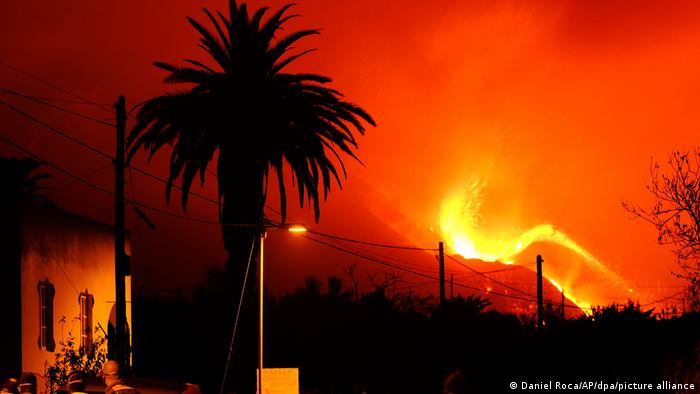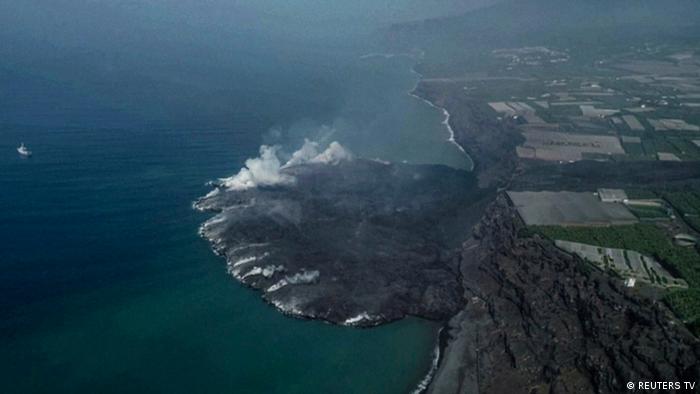Thousands locked down as La Palma volcano destroys cement works

On Saturday, part of the volcano's cone collapsed, sending new rivers of lava pouring down the slopes towards an industrial zone
Issued on: 11/10/2021 -
Isla de La Palma (España) (AFP)
Up to 3,000 residents of the Spanish island of La Palma on Monday were ordered to stay indoors after lava from a volcano destroyed a cement works, raising fresh fears of toxic gases.
La Cumbre Vieja volcano began erupting on September 19, forcing 6,000 people from their homes as the lava scorched its way across 600 hectares (1,400 acres) of land.
Miguel Angel Morcuende, head of the cell handling the crisis, told journalists Monday that part of the cement factory had gone up in flames.
"Consequently, and until we can analyse if the air quality allows for normal life, we have decided to lock down," he added.
The order concerns between 2,500 and 3,000 people living near the cement works on the west of the island in the Canaries archipelago, he said.
On Saturday, part of the volcano's cone collapsed, sending new rivers of lava pouring down the slopes towards an industrial zone.
Flights to the island resumed on Saturday after two days on hold because of the ash blasted from the volcano.
Despite the damage from the eruption -- more than 1,200 buildings have been destroyed, say local officials -- no has so far been killed or injured in the disaster.
This is the third volcanic eruption on La Palma Island, home to 85,000 people, in a century, although the last one dates back to 1971.
© 2021 AFP
Handout Spanish Geological and Mining Institute (IGME-CSIC)/AFP
Issued on: 11/10/2021 -
Isla de La Palma (España) (AFP)
Up to 3,000 residents of the Spanish island of La Palma on Monday were ordered to stay indoors after lava from a volcano destroyed a cement works, raising fresh fears of toxic gases.
La Cumbre Vieja volcano began erupting on September 19, forcing 6,000 people from their homes as the lava scorched its way across 600 hectares (1,400 acres) of land.
Miguel Angel Morcuende, head of the cell handling the crisis, told journalists Monday that part of the cement factory had gone up in flames.
"Consequently, and until we can analyse if the air quality allows for normal life, we have decided to lock down," he added.
The order concerns between 2,500 and 3,000 people living near the cement works on the west of the island in the Canaries archipelago, he said.
On Saturday, part of the volcano's cone collapsed, sending new rivers of lava pouring down the slopes towards an industrial zone.
Flights to the island resumed on Saturday after two days on hold because of the ash blasted from the volcano.
Despite the damage from the eruption -- more than 1,200 buildings have been destroyed, say local officials -- no has so far been killed or injured in the disaster.
This is the third volcanic eruption on La Palma Island, home to 85,000 people, in a century, although the last one dates back to 1971.
© 2021 AFP
Spain's National Geological Institute said the volcano spewed blocks of molten lava "as large as three-story buildings." A partial cone collapse near the volcano's emission vent triggered the event.

The La Palma volcano has destroyed over 1,000 buildings
Spanish authorities said on Sunday that a new destructive lava flow was being monitored in the island of La Palma. The volcano has been continuously erupting for there for three weeks.
Spain's National Geological Institute (ING) said there were 21 seismic movements detected on Sunday, with the largest measuring 3.8 on the Richter scale, which caused the ground to shake, in the villages of Mazo, Fuencaliente and El Paso.
The ING published footage of the new lava flow, warning about blocks of molten lava that it said were "as large as three-story buildings" rolling down the hillside.
In a video posted on their Twitter account, giant lava rocks could be seen floating in a large river of lava, moving at high speed.
The Canary Islands Volcanology Institute said the lava flow, with temperatures of up to 1,240 degrees Celsius (2,264 degrees Fahrenheit), destroyed the last few buildings that remained standing in the village of Todoque.
Partial cone collapse
On Saturday, ING reported that a partial cone collapse near the volcano's emission vent had taken place. This is said to have triggered the giant lava rocks that spilled out.
"The collapse of the northern flank of the Cumbre Vieja volcano has caused the release of large blocks of material and the appearance of new flows that run through areas already evacuated," tweeted Spain's National Security Department.
"The lava has reached the Camino de la Gata industrial estate and new buildings," the agency added.
So far, 1,186 buildings have been destroyed by the continuous eruption of the Cumbre Vieja volcano since it began on September 19, the Canary Islands Volcanic Institute said.
Some 493 hectares (1,218 acres) of land have been engulfed by the lava rivers, said Miguel Ángel Morcuende, technical director of the Canary Islands Volcanic Emergency Plan (Pevolca) organization.
Around 6,000 of La Palma's 83,000 inhabitants have been evacuated from their homes as a result of the eruption.
Lava creates new land
La Palma is part of Spain's Canary Islands, which is located in the Atlantic Ocean, near northwest Africa. The island's economy depends on the cultivation of the Canary plantain and tourism.
"We cannot say that we expect the eruption that began 21 days ago to end anytime soon,'' said Julio Perez, the regional minister for security on the Canary Islands.
The three-week eruption has already seen lava flows reach the ocean, dumping so much volcanic material that new land was created. Authorities sealed off the maritime area, as the lava's contact with the water released toxic gases.
Government experts estimated that new land being formed where lava is flowing into the Atlantic has reached a surface of 34 hectares.
Scientists have warned that if the new land continues to grow outwards into the sea, parts of it could break off and generate explosions, gas emissions and large waves.
jcg/rc (Reuters, EFE)


No comments:
Post a Comment